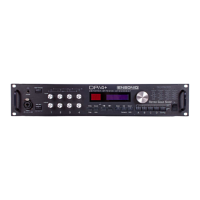Section 4 - Algorithms
GATED REVERB
00
-
Gated
Reverb
provides
a superb
gated
reverb. When a reverb is
muted
partway
through, it
creates a gated
sound.
To achieve this
gated
effect,
both
the
Gated
and
Reverse reverbs
must
gate
a
number
of internal parameters,
not
just
the
output
amplitude envelope.
It
is however, the
output
amplitude
over
which
the
user
has
control. The DP / 4 offers a highly controllable gated
reverb, optimized for percussive instruments,
but
useful for
any
input
signal. The gate is first
opened
when
the
input
signal passes
the
trigger threshold. This trigger threshold is set as low as
possible
by
the user, so
that
none
of the
input
signal is missed. The
gated
reverb is distinguished
from
the
reverse reverb
by
retriggering
whenever
the
input
signal passes a retrigger (user
programmable) threshold (see diagrams). The gate will stay
open
as
long
as the
input
signal
remains above
the
retrigger threshold,
and
all the
input
signals will
be
accumulated
under
this
gate
until
the total
input
signal level falls
below
the retrigger threshold.
When
this happens, the
Hold
Time will
begin
(as
shown
in
the
diagram
below). The reason there are
two
thresholds is to
eliminate false retriggering
and
to
ensure
precise
hold
time durations.
If
you
desire a separate
gate
on
each
and
every
note, use the
Non
Lin reverbs. The topology for
the
Gated
Reverb is
derived from the
Plate Reverb.
Gated Reverb with a High Retrigger Threshold
Hold Time
~--------------~
Release
Attack
Time
~_~!
I
1-+----+------------+---+
1
--
Retrigger
I
Level
HJ---\-+----ir--lHhf--\-A-.,.~--+----i
I
--
Trigger
Time
Gated Reverb with a Low Retrigger Threshold
l
0 Ime
;.
f'
I
Hold Time
-""
,
r Hold Time ;.
l
Hold Time
l
,
1
~
old Time
...
Holi::lllime
"-
H
Ie
Time
Level
Hoi
jtim~
I
I
"
J
;
j'
r\
;1
h
! I
, r
A
V
V V V
V
\f'o-.....
___
Signal
-
Time
ENSONIQ DP/4 Musician's Manual
I
Retrigger
Trigger
67

